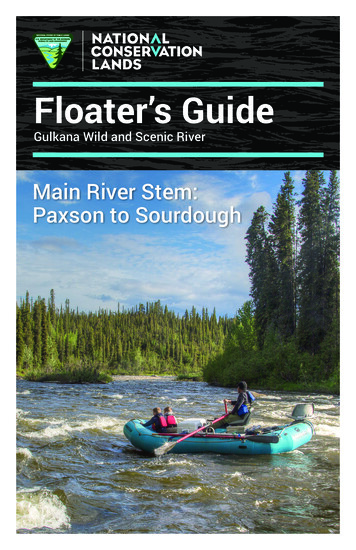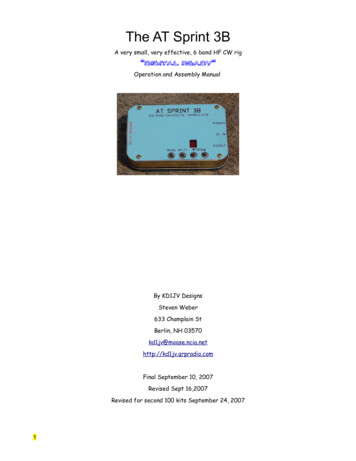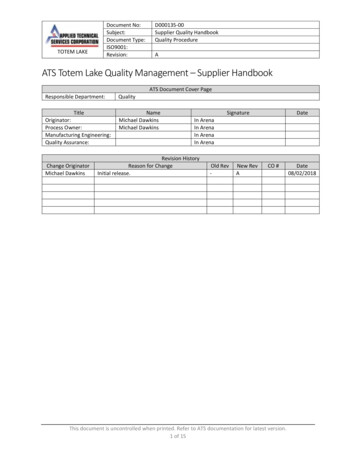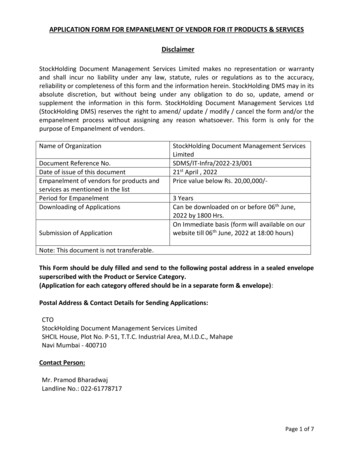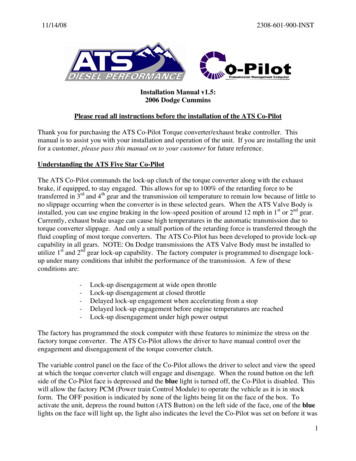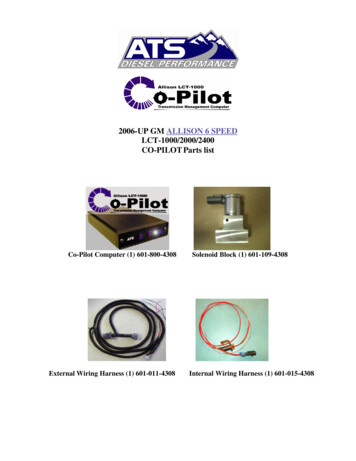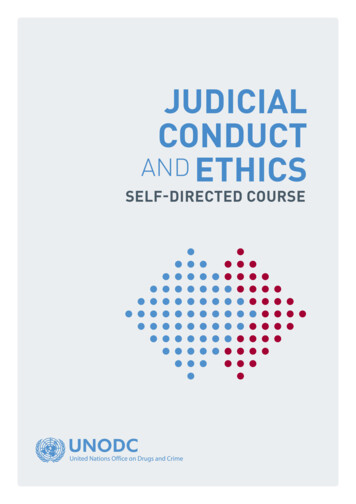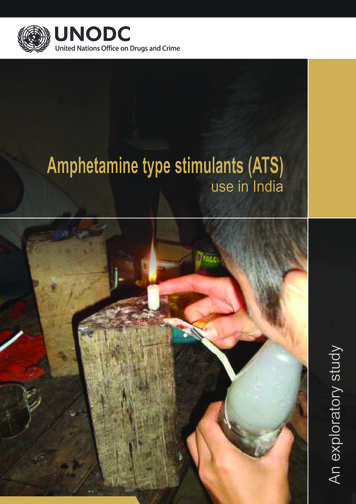
Transcription
Amphetamine type stimulants (ATS)An exploratory studyuse in India
Amphetaminetypestimulants (ATS)use in IndiaAn exploratory studyProject RAS/H13: Prevention of transmission of HIV amongst drugusers in SAARC countries
Year of Publication: 2015Published By:United Nations Office on Drugs and Crime, Regional Office for South AsiaAuthors:Dr. M Suresh Kumar, Dr. Subha KumarSupported by:Dr. Alpna Mittal, Ms. Archana Oinam, Mr. Debashis Mukherjee, Mr. Kunal Kishore,Dr. Rani MohanrajAll rights reservedThe text of this publication may be freely quoted or reprinted with proper acknowledgment.Disclaimer:The opinions expressed in this document do not necessarily represent the official policy of theUnited Nations Office on Drugs and Crime. The designations used do not imply the expression of anyopinion whatsoever on the United Nations concerning the legal status of any country, territory or areaof its authorities, frontiers and boundaries.The boundaries and names shown on the maps do not imply official endorsement or acceptance bythe United Nations.All the visual elements included in this document have been used for aesthetic purposes and donot express views and opinions of UNODC on the socio-cultural and religious values that they maysignify.Designed & Printed by:AB Impression Pvt. Ltd.
PrefaceEvidence from across the globe shows that the use of Amphetamine Type Stimulants (ATS) –one of the more recent drugs - is growing quickly and likely to further increase. India is noexception to the trend: over the last few years, law enforcement agencies have unearthedlaboratories producing amphetamine-group substances in several parts of the country.Along with China, India is frequently mentioned as a source country of illicit shipments ofephedrine and pseudoephedrine, two substances that are used to manufacture ATS and agroup of related substances that includes a wide range of other substances also such asmethcathinone, fenetylline, methylphenidate and MDMA or ‘Ecstasy’ – an amphetamine-typederivative with hallucinogenic properties.In India, the extent, trends and patterns of the use of ATS and related drugs have not beenstudied scientifically, making it difficult to visualize the problem to the public in generaland to provide a basis for policy makers and national and international stakeholders todevelop a common understanding and response. The only data available so far are seizuredata from drug law enforcement agencies and testimonies from the drug user communitynetworks, which both suggest that the spread of ATS use is expanding across the country.Awareness and knowledge regarding its health and social consequences are limited andso is consequently the response in terms of health services. Accordingly, in some partsof the country where ATS use is being reported in health facilities, responses are neitherintegrated nor consistent.The present study was conducted by the UNODC Regional Office South Asia as a first steptowards developing a better understanding of the potential scenario of a future “ATS useepidemic” in India which can be prevented, if we act now. The study was conducted usinga combination of both quantitative and qualitative research methods. Data were collectedthrough qualitative in-depth interviews and through a structured quantitative questionnaireapplied in five locations in India. These had been consciously identified based on reportedevidence regarding the use of amphetamine-group substances.Based on the findings of the study, we now can state that the present situation in Indiarequires serious attention to prevent that it escalates into a major epidemic of ATS,methamphetamine and/or ecstasy use. We should learn from experience in other countriesin Asia and not act too late.I am confident that this report will serve as a good basis for policy-makers in India todevelop a comprehensive response that is health-centric and sensitive towards the needs ofthe drug using community – both men and women – young and old.Cristina AlbertinRepresentativeAmphetamine type stimulants (ATS) use in India - An exploratory studyiii
AcknowledgementsThis research report is the result of the efforts of several individuals, nongovernmental organizations working with people who use drugs in thestates of Manipur, Mizoram, Punjab, Tamil Nadu and West Bengal, variousexperts in the field and, most importantly, people who use amphetaminetype stimulants in seven cities of Aizawl, Champhai, Chandigarh, Chennai,Churachandpur, Kolkata, Moreh across five states of India.Dr. M. Suresh Kumar, authored the report along with Dr. Subha Kumar,Dr. Rani Mohanraj of SAMARTH, Chennai with significant support from UNODCROSA staff Dr. Alpna Mittal, Technical Officer; Ms. Archana Oinam,TechnicalOfficer; Mr. Debashis Mukherjee, Research Officer; Ms Isheeta Sumra,Communication Officer; Mr. Kunal Kishore, Project Coordinator.The following research team members collected data for the study fromdifferent locations:Aarthi from Chennai; Chingsubam Bangkim fromChurachandpur, Imphal, Moreh in Manipur; Kongtea Kong from Aizawl,Champhai in Mizoram; Neil Roberts from Chandigarh; and Sutirtha Duttafrom Kolkata. Furthermore, Chingsubam Bangkim and Kongtea Kongobtained qualitative data from key stakeholders in the India-Myanmarborder towns of Moreh, Manipur and Champhai, Mizoram.Amphetamine type stimulants (ATS) use in India - An exploratory studyv
AbbreviationsAIDSAcquired Immunodeficiency SyndromeATSAmphetamine Type StimulantsB. ABachelor of ArtsB.ComBachelor of CommerceB.EBachelor of EngineeringB. ScBachelor of ScienceB. TechBachelor of TechnologyCBOCommunity Based OrganizationCDCCenter for Disease ControlDICDrop-In CentreDJDisc JockeyHTCHill Tribal CouncilHIVHuman Immunodeficiency VirusIBMInternational Business Machines CorporationICDInternational Classification of DiseasesIDUInjecting Drug UserIDU-TIsInjecting Drug User Targeted InterventionsIECInformation Education and CommunicationIGPIncome Generating ProgramJACJoint Action CommitteeKgKilogramKmKilometerLLBBachelor of Legislative LawLSDLysergic acid DiethylamideMAMaster of ArtsMBBSBachelor of Medicine and Bachelor of SurgeryMDMA3,4-methylenedioxy-methamphetamine (Ecstasy)MLAMember of Legislatoive AssemblyMNFMizo National FrontNCBNarcotics Control BureauNGONon-Governmental OrganizationODOverdoseAmphetamine type stimulants (ATS) use in India - An exploratory studyvii
viiiPGPost GraduateSASOSocial Awareness Service OrganizationSDStandard DeviationSDPOSub Division Police OfficerSHGSelf Help GroupSPSpasmoproxyvonSSHShort Stay HomeSPSSStatistical Package for Social SciencesSTIsSexually Transmitted InfectionsTITargeted InterventionTVTelevisionUG groupsUnderground groupsUKUnited KingdomUNODCUnited Nations Office on Drugs and CrimeUNODCROSAUnited Nations Office on Drugs and Crime-RegionalOffice for South AsiaUSUnited StatesVIPVery Important PersonWHOWorld Health OrganizationYMAYoung Mizo AssociationAmphetamine type stimulants (ATS) use in India - An exploratory study
TableofContentsPreface. iiiAcknowledgements. vAbbreviations. viiExecutive Summary. xiii1. Background. 12. Objective. 53. Methodology. 93.1. Sites. 113.2. Sampling and recruitment. 113.3. Data collection and procedure. 123.4. Analysis of the data. 133.5. Problems encountered during the survey and in-depth interviews. 143.6. Ethics and consent. 143.7. Sample characteristics. 144. Findings. 154.1. Quantitative study findings. 174.2. Comparison of males and females who useAmphetamine type stimulants (ats) drugs. 244.3. Comparison of people who use Amphetamine type stimulants (ats)drugs from metro cities and northeast region. 254.4. Characteristics of people who are dependent onAmphetamine type stimulants (ATS) drugs. 284.5. Qualitative study findings. 304.6. Cross border study on ATS. 75Amphetamine type stimulants (ATS) use in India - An exploratory studyix
5. Summary. 995.1. Survey with persons who use ATS drugs. 1015.2. Qualitative study with persons who use ATS drugs. 1035.3. History of substance use. 1035.4. ATS use and awareness about harms of drug abuse. 1035.5. Effects of ATS. 1045.6. Treatment. 1045.7. Indo-Myanmar cross border study related to ATS. 1055.8. Limitations of the study. 1065.9. Recommendations. 1066. Conclusions. 1077. References. 111xAmphetamine type stimulants (ATS) use in India - An exploratory study
List of Figures1. Drug use history. 182. Age at initiation of drugs. 183. ATS drugs ever used. 194. Signs and symptoms of ATS dependence. 21List of Tables1. Seizure of methamphetamine since 2011, India. 42. Number of Interviews from study sites. 123. Demographic characteristics of people who use ATS drugs (N 100). 174. ATS drug use pattern. 205. Reasons for using ATS drugs. 206. ATS and Mental health related issues. 217. ATS use and legal issues. 238. Help preferred by ATS users. 239. Comparison of males and females for certain variables. 2410. Comparison of people who use ATS drugs from Metro cities and Northeast region. 2511. Comparison of people who use ATS drugs from Metro cities and Northeast region. 2612. Comparison of people who are dependent on ATS drugs with those not dependent onATS drugs. 2813. Demographic characteristics- Aizawl. 3014. Demographic characteristics – Imphal. 3115. Demographic characteristics- Chandigarh. 3116. Demographic characteristics - Kolkata. 3117. Demographic characteristics- Chennai. 3218. Demographic characteristics- Moreh, Manipur. 7519. Demographic characteristics- Champhai, Mizoram. 76Amphetamine type stimulants (ATS) use in India - An exploratory studyxi
xiiAmphetamine type stimulants (ATS) use in India - An exploratory study
Executive SummaryAmphetamine type stimulants (ATS) use in India - An exploratory studyxiii
Executive SummaryAlthough amphetamine type stimulants (ATS) use is emerging in several parts of India,information related to the extent, patterns of ATS use and adverse consequences associatedwith its use is almost non-existent at present. Hence United Nations Office on Drugs andCrime Regional Office for South Asia (UNODC ROSA) carried out an explorative study onATS use in eight selected cities/towns across five states of India. The methodology includedquantitative as well as qualitative assessments. Survey questionnaire based interviews weredone with 100 persons who have used ATS from Aizawl, Champhai in Mizoram; Chandigarh;Chennai, Tamilnadu; Churachandpur, Imphal, Moreh in Manipur; and, Kolkata, West Bengalto elicit demographics, pattern of ATS and other drug use, dependence on ATS, adversehealth, other consequences and help seeking behaviour. In-depth interviews with fortyseven persons who use ATS drugs from the above sites who agreed to provide detailedinformation were conducted exploring demographics, history of ATS use, experiences/awareness of harmful effects of ATS use and perceptions on treatment. Additionally, indepth interviews were carried out with ten stakeholders such as community leaders, drugpeddlers and other individuals aware about the movement and procurement of ATS in eachof the India-Myanmar border towns of Champhai in Mizoram and Moreh in Manipur. Amongthe 100 survey participants the median age was 25 years (mean SD: 26 5 years); 25females completed the survey. Among the 47 qualitative study participants, the median agewas 26 years (mean SD: 27 7 years); there were 12 female respondents. Of the 20 keystakeholders in the cross-border study, the median age was 35 years (mean SD: 36 9years); six of the stakeholders were females.About two thirds (63%) of the survey respondents had received college level education and29 percent were students. More than half (53%) were engaged in full time employment.Majority (62%) of the respondents were single. A small proportion (19%) reported earningmore than Rs. 30001/- per month. The respondents reported using tobacco (98%), alcohol(97%), cannabis (63%) and pharmaceutical drugs (16%) prior to the use of ATS. The medianage of first use of tobacco was 15 years (mean age: 15 2 years) followed by alcohol witha median age of 16 years (mean age: 15 2 years). Initiation into Illicit drugs was reportedto begin with cannabis and pharmaceuticals at the median age 16 years (mean age: 17 3 years).The mode of first drug use was reported to be smoking in 71 per cent of theparticipants. Use of ATS was reported to commence by the median age of 21 years (meanage: 22 5 years).Ecstasy was the most commonly used among the ever-used ATS drugs and more than a halfof participants (55%) reported ever using it. Methamphetamine pills were used by 42 per centof the respondents followed by methamphetamine powder (36%) and amphetamine (35%). Inthe major cities, the commonly used substances include ecstasy, methamphetamine powder(referred as ice) and amphetamine (referred as speed). In northeast states the commonlyAmphetamine type stimulants (ATS) use in India - An exploratory studyxv
used ATS was methamphetamine pills; in Manipur they are referred as WY pills, 88, 626and in Mizoram as ‘speedy bee’, ‘meth’ and ‘W’. When enquired about last use, 27 percent reported using methamphetamine pills during the week of the interview. Ecstasy wasreported to be last used in the past one-month by 13 per cent and amphetamine by 8 percent. None of the respondents reported injecting ATS drugs. Ninety three per cent of therespondents reported having friends who used ATS. On an average, participants spent Rs.3300 for one episode of ATS use. More than three-fourths (78%) of them also reported usingATS in combination with other drugs. The reported reasons for initiation were ‘curiosity’(57%) and ‘peer influence’ (17%); for continuation were like the ‘effect of the drug’ (38%) and‘to get pleasure’ (21%); and, for current use of ATS were ‘to be more energetic’ (31%) and‘party drug’ (20%).More than half (58%) reported having used ATS before sex with regular partner, almost half(49%) used ATS before sex with a casual partner and 12 percent said that they had usedit before sex with a sex worker. Condom use during sex after ATS use was reported onlyby 31 per cent of respondents. About half of the participants (48%) are dependent usersof ATS and the ATS dependence is characterized by three of more criteria for substancedependence by WHO - ICD-10. About two third (62%) reported craving, about three fifth(59%) experienced withdrawal, half (51%)of the respondents had problems in social lifeand 44 per cent continued ATS despite psychological or physical harm and for 46 per centATS use lead to harm at home/work. About half (49%) reported tolerance, one-third (33%)reported impaired control. More than half (55%) reported ATS use in risky situations, while,31 per cent reported pre occupation with ATS having given up work or recreation and morethan one fifth (22%) had problems with law resulting from ATS use.A quarter of the participants admitted to mental health problems after the use of ATS. Morethan a half (57%) reported some of the time feeling “aggressive or hostile after ATS use” and14 percent most of the time. Nearly half of them (49%) “felt sad and depressed after ATSuse” some of the time and more than half (53%) reported “feeling nervous after ATS use”some of the time. Forty two per cent reported some of the time “fear of being talked aboutor harmed after ATS use” and 31 per cent reported some of the time having “heard voices orseen figures after ATS use”. Thirty-five per cent of respondents experienced most of the time“sleep problems after ATS use”. A third (33%) of the participants reported having “physicalproblems due to ATS use”. Eighteen per cent of the respondents had been apprehended bythe police after ATS use and 7 per cent had been in police lock-up after ATS use.Nearly a half (49%) of the respondents required any help or assistance for the ATS use. Whilenearly a fourth (24%) required medical intervention, more than a third (37%) of them and athird (33%) of participants required mental health services or counselling respectively. Onlya small proportion (16%) believe that they required help for their drug use per se throughdrug treatment services and only 18 percent of the respondents required drug rehabilitationservices for ATS use. While 39 per cent of respondents required education related to ATS,29 per cent opined that self help groups may be helpful. While 28 per cent reported seekinghelp from friends, only a small proportion (8%) sought help with family members. Fifteenpercent “ever sought help with any psychosocial /mental health services for ATS use”, onlysix per cent each reported ever seeking help from any medical or any drug use treatmentservices for ATS use.xviAmphetamine type stimulants (ATS) use in India - An exploratory study
Compared with females, significantly more males who use ATS drugs have initiated alcoholat an earlier age; more likely to use ATS in risky or dangerous situations such as drivingafter ATS use; used ATS prior to sex with regular and sexual partners; and, desired self helpgroups to assist with ATS use.The following characteristics have been found to be statistically significantly associatedwith people who use ATS drugs living in the three metro cities of Chandigarh, Chennai andKolkata compared with ATS users from Manipur and Mizoram in northeast: the ATS usersfrom metros were younger; more students; more had college level education; and greatermonthly income; used ecstasy, methamphetamine powder more often and used ATS drugsin combination with other substances; and encountered legal problems after ATS use. Thefollowing characteristics have been found to be statistically significantly associated withpeople who use ATS drugs living in northeast states of Manipur and Mizoram compared withATS users from metro cities: used ATS as a single drug; the commonly used ATS drug wasmethamphetamine pill; engaged in risky and dangerous situation subsequent to ATS use;more dependent users; experienced physical problems due to ATS use; neglected work asa consequence of ATS; given up work after ATS use; interference to social life subsequentto ATS; required assistance for ATS use; and, sought educational intervention, medicalassistance and drug rehabilitation services for ATS use.The following characteristics have been found to be statistically significantly associated withpeople who were dependent on ATS drugs compared with non-dependent users in the sample:hailed from northeast region; younger age at initiation of tobacco use; methamphetaminepill use; used ATS prior to sex with sex workers and casual sex partners; engaged in riskysituations after ATS use; reported sick after ATS use ; experienced more physical problemsdue to ATS use; reported more mental health problems; more aggression, fear, persecutoryideas, hallucinations; consumed ATS larger quantities or for longer period; more adverseconsequences such as interference to social life and neglect of work given up work; and,sought assistance for ATS use, specifically medical assistance.The findings of the survey were validated in the qualitative interviews. The context andsettings of ATS use was highlighted in the in-depth interviews. Participants from the northeastern sites belonged to poorer socio-economic groups as compared to those from themetro cities. The latter were also younger in age and used drugs like ATS mostly in partieswhereas the participants from the north-east sites would usually gather in the home of adrug peddler and use ATS drugs that were relatively cheaper in these settings. In northeastthese drugs were used to enhance their work performance and partly to escape from thereality of their harsh daily lives.The Indo-Myanmar cross border study of ATS use revealed drug peddling as a flourishingbusiness across the porous borders. The drugs were usually brought into the countryfrom Myanmar by tribal people and other migrant communities living along the borderand therefore familiar with the terrain; a large number of women too were involved indrug trafficking. The types of ATS commonly found in border towns were WY, 626 and 88and are relatively cheaper. ATS was seen as being less addictive as compared to heroinand perceived to enhance productivity at work. Smoking was the most common method ofAmphetamine type stimulants (ATS) use in India - An exploratory studyxvii
ingesting the ATS drugs. Using a soft drink plastic bottle and some straw and silver foil,users would burn the tablet inside the bottle and using the straw inhale the emerging smoke.Improving the livelihoods of people was seen as an important step towards controlling thedrug trade. Providing medical intervention and counselling for ATS use was suggested bythe stakeholders as an important step as very poor drug treatment facilities were available inthese towns. Involving the families of ATS/drug users thereby creating a supportive systemwould help ATS drug users in their recovery.The sample covered persons who have used ATS drugs in five different states and it may nottruly reflect and represent the people who use ATS drugs across the country and additionally,the number of persons recruited at each locale is small. The current study is explorativeand a detailed assessment in the country is necessary to know the extent and patterns ofATS use, which will be helpful to devise appropriate prevention and treatment interventionsfor people who use ATS drugs. Currently the strategies to recruit people who inject drugsis through street outreach from various parts of the country and this strategy may not beuseful to identify and engage people who use ATS drugs. In metro cities it is seen as part ofthe ‘party culture’ and hence innovative strategies may need to be utilised to reach out tothem. At present the knowledge related to ATS use is insufficient and hence the top priorityis to develop appropriate information, education and communication (IEC) materials forthe users. Social media can be considered in the dissemination of IEC materials for youngpersons who are vulnerable to use ATS. As mental health problems are predominant in thisgroup, engaging and involving the mental health service providers in the development ofintervention strategies is critical. Capacity building of service providers and professionalsproviding drug use prevention/treatment interventions is critical for effectively addressingthe emerging ATS use in young populations across the country.xviiiAmphetamine type stimulants (ATS) use in India - An exploratory study
BackgroundAmphetamine type stimulants (ATS) use in India - An exploratory study1
2Amphetamine type stimulants (ATS) use in India - An exploratory study
Background1Amphetamine type stimulants (ATS) consist of amphetamine-group substances andecstasy-group substances. Amphetamine-group substances include amphetamine,methamphetamine and their derivatives, such as methcathinone, fenetylline, andmethylphenidate. Methamphetamine (commonly called “speed,” “ice,” “crystal,” “glass”) canbe easily made in clandestine laboratories from readily available, inexpensive ingredients.Laboratories producing amphetamine-group substances, including large scale laboratoriescapable of industrial-scale manufacture, have been identified in most countries in the Asianregion. In addition, there is increase in the use of ecstasy-group substances (i.e., MDMA) inthe region.UNODC (2010) estimated that up to 20.7 million individuals in Asia and the Pacific haveused ATS in the past year (Global Smart Programme, 2010). Its use is increasing in eastand south east Asia and the Middle Eastern region. Amphetamine-type stimulants can besnorted, smoked, injected, or used rectally. Compared with opioids, most users of ATSadminister the drug through non-injecting route.Intake of ATS, notably the amphetamine-group substances results in euphoria, increasedalertness, arousal and libido and elevated heart rate, respiratory rate, blood pressure; inaddition, users perceive heightened confidence, energy levels and physical strength (Barr etal, 2006). The HIV-related risks associated with amphetamine group substance use are welldocumented in the literature and majority of studies demonstrate an association betweenamphetamine-group substance use and risk of HIV infection, in particular among men havingsex with men (Colfax et al, 2010).In India, the extent, pattern and consequences of ATS use has not been studied. Over thelast few years, laboratories producing amphetamine-group substances have been unearthedby law enforcement agencies from several parts of the country. India along with Chinais the most frequently mentioned source country of seized illicit shipments of ephedrineand pseudoephedrine which can be used to manufacture ATS (UNODC, 2011). Anecdotalreports and clinical data indicate the emergence of use of these substances in several partsof the country. During the last two years there are a number of media reports on ATS usein party, ‘rave’ settings; and, distribution and smuggling related to ATS and other newerparty drugs. Additionally reports from the Narcotics Control Bureau indicates that in therecent years there is increase in ATS seizures from several parts of the country, notably thenortheast region. Arrests related to ATS smuggling has been reported in several parts of thecountry. During 2011 and 2012 significant ATS seizures have been reported from Mizoram,Ahmedabad, Imphal and Maharashtra.Amphetamine type stimulants (ATS) use in India - An exploratory study3
Table 1. Seizure of methamphetamine since 2011, IndiaSl. No. Se
Amphetamine type stimulants (ATS) use in India - An exploratory study xv Although amphetamine type stimulants (ATS) use is emerging in several parts of India, information related to the extent, patterns of ATS use and adverse consequences associated with its use is almost non-existent at present. Hence United Nations Office on Drugs and Crime Regional Office for South Asia (UNODC ROSA) carried .


